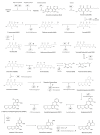Aflatoxin Biosynthesis and Genetic Regulation: A Review
- PMID: 32121226
- PMCID: PMC7150809
- DOI: 10.3390/toxins12030150
Aflatoxin Biosynthesis and Genetic Regulation: A Review
Abstract
The study of fungal species evolved radically with the development of molecular techniques and produced new evidence to understand specific fungal mechanisms such as the production of toxic secondary metabolites. Taking advantage of these technologies to improve food safety, the molecular study of toxinogenic species can help elucidate the mechanisms underlying toxin production and enable the development of new effective strategies to control fungal toxicity. Numerous studies have been made on genes involved in aflatoxin B1 (AFB1) production, one of the most hazardous carcinogenic toxins for humans and animals. The current review presents the roles of these different genes and their possible impact on AFB1 production. We focus on the toxinogenic strains Aspergillus flavus and A. parasiticus, primary contaminants and major producers of AFB1 in crops. However, genetic reports on A. nidulans are also included because of the capacity of this fungus to produce sterigmatocystin, the penultimate stable metabolite during AFB1 production. The aim of this review is to provide a general overview of the AFB1 enzymatic biosynthesis pathway and its link with the genes belonging to the AFB1 cluster. It also aims to illustrate the role of global environmental factors on aflatoxin production and the recent data that demonstrate an interconnection between genes regulated by these environmental signals and aflatoxin biosynthetic pathway.
Keywords: Aspergillus; aflatoxin; biosynthesis; gene regulation.
Conflict of interest statement
The authors declare no conflict of interest.
Figures




References
-
- Frisvad J.C., Hubka V., Ezekiel C.N., Hong S.B., Nováková A., Chen A.J., Arzanlou M., Larsen T.O., Sklenář F., Mahakarnchanakul W., et al. Taxonomy of Aspergillus section Flavi and their production of aflatoxins, ochratoxins and other mycotoxins. Stud. Mycol. 2019;93:1–63. doi: 10.1016/j.simyco.2018.06.001. - DOI - PMC - PubMed
-
- Bbosa G.S., Kitya D., Lubega A., Ogwal-Okeng J., Anokbonggo W.W., Kyegombe D.B. Review of the Biological and Health Effects of Aflatoxins on Body Organs and Body Systems. In: Razzaghi A., editor. Aflatoxin-Recent Advances and Future Prospects. Volume 12. InterchOpen; London, UK: 2013. pp. 239–265.
-
- Gauthier T., Duarte-Hospital C., Vignard J., Boutet-Robinet E., Sulyok M., Snini S.P., Alassane-Kpembi I., Lippi Y., Puel S., Oswald I.P., et al. Versicolorin A, a precursor in aflatoxins biosynthesis, is a food contaminant toxic for human intestinal cells. Environ. Int. 2020;137:105568. doi: 10.1016/j.envint.2020.105568. - DOI - PubMed
Publication types
MeSH terms
Substances
Grants and funding
LinkOut - more resources
Full Text Sources

